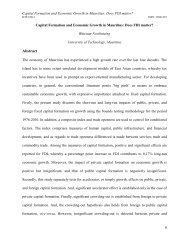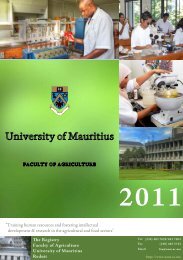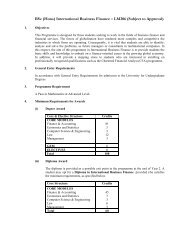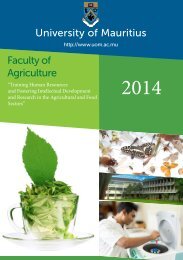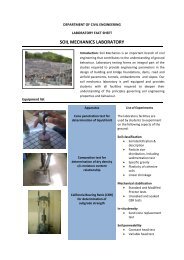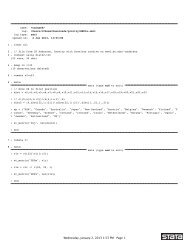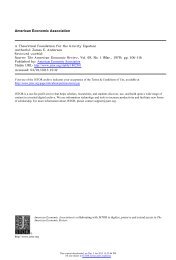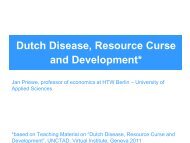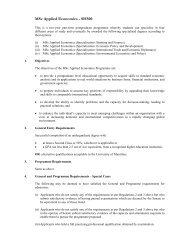SACU Revenue Sharing Formula - the University of Mauritius
SACU Revenue Sharing Formula - the University of Mauritius
SACU Revenue Sharing Formula - the University of Mauritius
You also want an ePaper? Increase the reach of your titles
YUMPU automatically turns print PDFs into web optimized ePapers that Google loves.
ICITI 2012 ISSN: 16941225The table below considers what fiscal surpluses/deficits would be in all <strong>SACU</strong> membersif <strong>the</strong> same <strong>SACU</strong> common external tariff were applied to extra-<strong>SACU</strong> imports and divided onthat basis ie <strong>the</strong> destination principle 45 . The table underestimate <strong>the</strong> amount <strong>of</strong> revenue thatcountries would derive if individual BLNS levied <strong>the</strong>ir own tariffs but did not tax South Africaimports because clearly with more stringent rules <strong>of</strong> origin and greater border inspection moreentrepot trade would be taxed. The BLNS would certainly capture far more entrepot and nonoriginatingtrade if revenue collection were on a destination basis at <strong>the</strong> final border. It ishowever a very broad indicator for <strong>the</strong> year 2007, an o<strong>the</strong>rwise „good year‟ from <strong>the</strong> point <strong>of</strong>fiscal balance when all <strong>SACU</strong> members ran surpluses. The figures in paren<strong>the</strong>ses are <strong>the</strong> actualsurplus or deficit in 2008. The third column presents <strong>the</strong> increase or decrease in revenue as apercentage <strong>of</strong> GDP that would result from a move to a formula based on a share <strong>of</strong> extra-<strong>SACU</strong>imports which is essentially <strong>the</strong> destination principle. The last column shows what <strong>the</strong> fiscalsurplus or deficit would be in <strong>the</strong> event <strong>of</strong> such a change. What is significant is <strong>the</strong> 0.9% increasein South African GDP and no doubt <strong>the</strong> main reason for much <strong>of</strong> <strong>the</strong> discussion on <strong>the</strong> subject inSouth Africa. Needless to say <strong>the</strong> deficits for <strong>the</strong> BLNS, but Lesotho and Swaziland in particular,such a change in <strong>the</strong> <strong>SACU</strong> formula would be unsustainable and would necessitate substantialadjustments in all BLNS countries.Table 5: Actual and Hypo<strong>the</strong>tical Surpluses and Deficits for 2007 and (2008)Actual Surplus(Deficit)/GDPLoss <strong>of</strong> <strong>SACU</strong><strong>Revenue</strong>/GDPHypo<strong>the</strong>tical Surplus(Deficit)/GDPBotswana 5.6 (-3.8) -9.2 ( -8.4) -3.6 (-12.2 )Lesotho 15.2 (4.0) -26.7 (-30.1) -11.5 (-26.1)Namibia 3.9 (-3.6) -7.8 (-9.3) -3.9 (-12.9)South Africa 0.8 (-0.6) 0.9 ( 1.0) 1.7 (0.4)Swaziland 6.5 (-0.5) -16.8 (-20.6) -10.3 (-21.1)Source: IMF, 2009, <strong>SACU</strong> Secretariat and authors‟ calculations NB: Values in paren<strong>the</strong>ses shows <strong>the</strong> analysis for<strong>the</strong> year 2008BotswanaThe 2002 <strong>SACU</strong> RSF significantly increased <strong>the</strong> importance <strong>of</strong> <strong>SACU</strong> revenues to <strong>the</strong>government <strong>of</strong> Botswana (see chart 4). In combination with <strong>the</strong> decline in diamond revenues it<strong>SACU</strong> revenues rose to 29% <strong>of</strong> total government revenue in 2009. As diamond prices recoveredin 2010 <strong>SACU</strong> revenues will once again become relatively less important. What is clear from <strong>the</strong>table below is that in <strong>the</strong> absence <strong>of</strong> <strong>the</strong> current <strong>SACU</strong> revenue formula Botswana would need toraise a tariff equivalent significantly higher than <strong>the</strong> trade weighted average in order to achieve arevenue neutral shift. This would <strong>of</strong> course mean imposing a tariff on imports from South Africaand <strong>the</strong>refore exiting SADC. Such a hypo<strong>the</strong>tical tariff would also have to be designed in such asway as not violate Botswana‟s bound rate obligations at <strong>the</strong> WTO.Table 5: Effective and Nominal <strong>SACU</strong> Duties for Botswana17RateNominal Average <strong>SACU</strong> Tariff (2009) 8.1%Trade Weighted Average (2008) 7.5%




